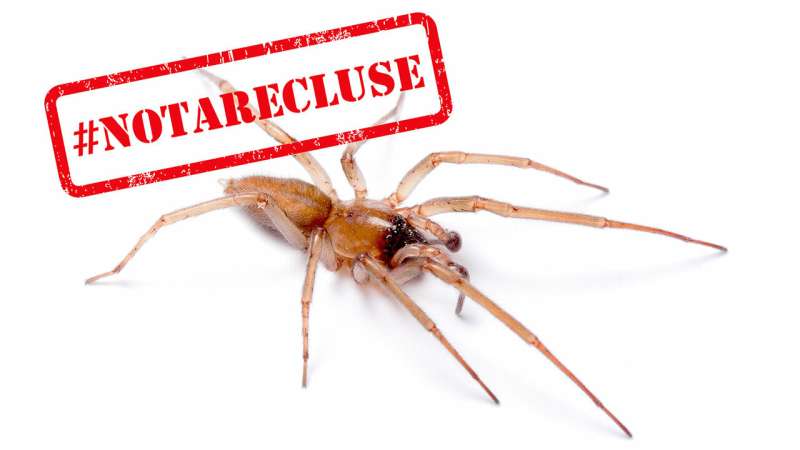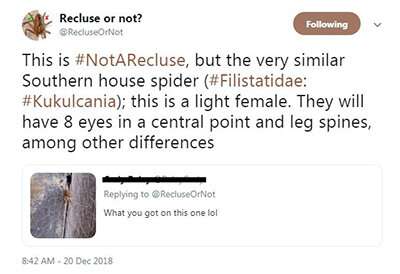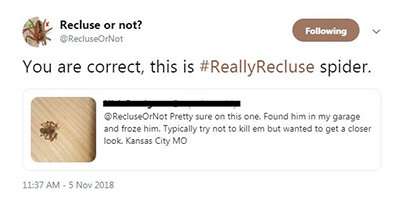'Is this a brown recluse?' A year of looking at spiders

In 2017, a group of us decided to tackle the ever-present problem of spider misidentification by creating the Twitter account @RecluseOrNot. Focused mainly around the eponymous recluse spiders – particularly, but not limited to, the brown recluse (Loxosceles reclusa) – our account uses social media to help people identify potential recluses and educate them about spiders in general.
At the time of writing this, we have 1,971 followers – a fairly respectable number, though we had no goal in mind when we started. In the first year of our account being active, from September 2017 to September 2018 (all of the data in this piece refer to this period), we had 548 submissions, or an average of about 1.5 submissions per day. There was a seasonality for submissions, though: we got fewer submissions in the winter months (about 5-20 per month) than we did during the summer months (about 70-90 per month).
Identification requests came from 13 countries, including India, Thailand, and the Philippines. Domestically, we received tweets from 45 states, Washington D.C., and Puerto Rico; the only states without submissions were Alaska, Delaware, Nevada, Rhode Island, and Wyoming. People all over the place wanted to know whether they had found a recluse.
As expected, there were a lot of images of non-recluse spiders submitted. In fact a total of 444 submissions (81 percent) were not recluses. In these cases we responded that they were #NotARecluse and described what features could be used to help distinguish them.

However, that means that 104 of the submissions (or 19 percent) were of actual recluse spiders. Responses to these submissions were tagged with #ReallyRecluse.
So which unfortunate spiders are people most often confusing with recluses?
The three most commonly misidentified groups were funnel weavers/grass spiders (Agelenidae), wolf spiders (Lycosidae), and fishing/nursery-web spiders (Pisauridae), making up close to 30 percent of all submissions. Other mistaken families included cobweb spiders (Theridiidae), orbweavers (Araneidae), crevice spiders (Filistatidae), and cellar spiders (Pholcidae).

As you probably can guess, many of these spiders are brown. But upon closer inspection there are features that can be used to distinguish them from recluses.
As far as where recluses were most commonly found, the pattern of #ReallyRecluse submissions was similar to our traditional knowledge of their range. Thus, most recluses were found well within the range, a few were found in marginal states, and a few (nine) were found outside the range (not an unknown phenomenon, but very rare). States that had more recluses submitted than non-recluses included Missouri, Oklahoma, Kansas, and Arkansas, while a few states had numerous submissions without a single recluse (e.g. California).
Provided by North Carolina State University





















